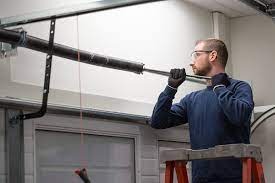Garage doors are a vital part of our homes, making life more convenient and secure. Yet, the unsung heroes of this convenience are the garage door springs. These springs work tirelessly behind the scenes, helping to lift and lower the heavy garage door. Over time, wear and tear can take their toll, leading to the need for garage door spring repair. In this article, we will delve into the world of Garage door spring repair without using points or bullet lists.

Understanding Garage Door Springs:
Two common types of garage door springs are torsion springs and extension springs. Torsion springs are usually located above the door and twist to lift and lower it. Extension springs, on the other hand, are mounted on the sides of the door and stretch and contract to assist in its movement. They are generally found in lighter residential doors.
Recognizing Signs of a Broken Spring:
One of the most noticeable signs of a broken garage door spring is a heavy door. If you find it suddenly challenging to lift the door manually, this could be a red flag. Another indicator is uneven movement, where one side of the door seems to rise or lower faster than the other. Sometimes, a loud bang that sounds like a gunshot will occur when the spring breaks, leaving no room for doubt. Additionally, inspect the springs for any gaps or separation, as visual cues can also point to a problem.
Prioritizing Safety:
Before embarking on any garage door spring repair, it's crucial to ensure safety. Start by disconnecting power to the garage door opener. Wear safety goggles and gloves to protect yourself from any potential debris. Also, keep bystanders at a safe distance from the repair area.
Gather the Necessary Tools:
Depending on the spring type, you will require specific tools. For torsion springs, you may need winding bars and a socket wrench, while extension springs may necessitate pliers and safety cables.
Release Tension:
For torsion springs, safely release tension by winding the spring to its unwound position. For extension springs, disconnect them from the pulley system.
In Conclusion:
Garage door spring repair is a task that can be tackled by DIY enthusiasts with the right tools and knowledge. However, remember to always prioritize safety. If you find the process too complex or the springs challenging to access, it's wise to consult a professional garage door repair service. Maintaining your garage door springs in good working order guarantees the continued reliability of your garage door, providing peace of mind and convenience for years to come.
